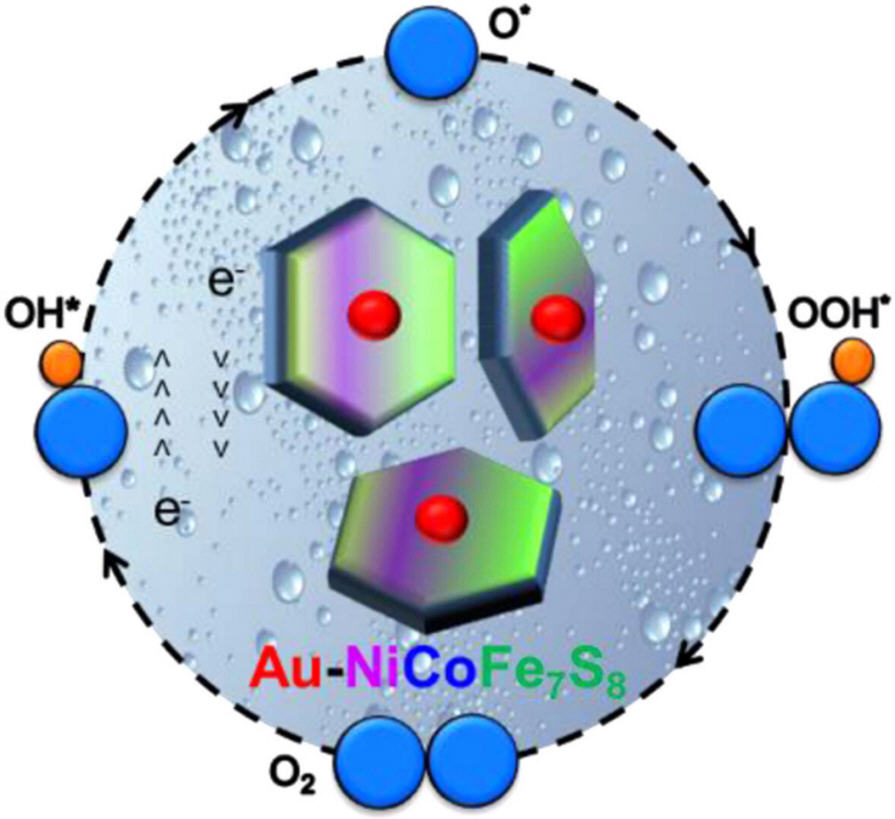博文
澳中科学家:清洁制氢的游戏规则改变者
 精选
精选
||
澳中科学家:清洁制氢的游戏规则改变者
诸平
Graphical abstract. Credit: DOI: 10.1016/j.nanoen.2021.106463
据澳大利亚科廷大学(Curtin University)2021年9月17日提供的消息,澳大利亚科学家和中国科学家合作,已经成功地改变了清洁制氢的游戏规则(Game-changer for clean hydrogen production),相关研究结果于2021年8月26日已经在《纳米能源》(Nano Energy)杂志网站发表——Shaghraf Javaid, Xiaomin Xu, Wei Chen, Jiayi Chen, Hsien-Yi Hsu, Sheng Wang, Xuyong Yang, Yunguo Li, Zongping Shao, Franca Jones, Guohua Jia. Ni2+/Co2+ doped Au-Fe7S8 nanoplatelets with exceptionally high oxygen evolution reaction activity. Nano Energy, Volume 89, Part B, November 2021, 106463. DOI: 10.1016/j.nanoen.2021.106463. Available online 26 August 2021.
参与此项研究的既有来自澳大利亚科廷大学(Curtin University)的研究人员,也有来自中国香港城市大学(City University of Hong Kong)、中国香港城市大学深圳研究院(Shenzhen Research Institute of City University of Hong Kong)、上海大学先进显示与系统应用教育部重点实验室(Key Laboratory of Advanced Display and System Applications of Ministry of Education, Shanghai University)、中国科技大学地球与空间科学学院,中国科学院壳幔物质与环境重点实验室(CAS Key Laboratory of Crust-Mantle Materials and Environments, School of Earth and Space Sciences, University of Science and Technology of China)的研究人员。
澳中科学家合作完成的此项研究发现了一种新的、更便宜、更有效的电催化剂(electrocatalyst),可以从水中生产绿色氢气,这可能在未来为大规模清洁能源生产开辟新途径。
通常,科学家们一直在使用贵金属催化剂(precious metal catalysts),如铂,来加速将水分解成氢气和氧气的反应。现在,澳中科学家合作完成的研究发现,将镍和钴添加到便宜的、以前无效的催化剂中,可以提高它们的性能,降低水分解所需的能量,提高了氢气的产量。
来自科廷大学分子与生命科学学院(Curtin's School of Molecular and Life Sciences)的首席研究员、也是上述研究论文的共同通讯作者之一的贾国华博士(Dr. Guohua Jia音译)表示,这一发现可能对未来的可持续绿色燃料生产产生深远影响。“我们的研究基本上是以二维的铁硫纳米晶体(iron-sulfur nanocrystals)为基础进行掺杂改造。在从水中获得氢的电驱动反应中,铁硫纳米晶体通常不起催化作用,但是加入少量的镍离子或钴离子(Ni2+/Co2+),结果会截然不同。当我们这样做的时候,完全可以将性能差的铁硫(iron-sulfur)化合物转化成了一种可行的、高效的催化剂。使用这些更丰富的材料比目前的基准材料氧化钌(ruthenium oxide)更便宜,效率更高。氧化钌是从钌元素得到的,价格昂贵。我们的发现不仅拓宽了现有的可能粒子组合的‘调色板(palette)’,而且还引入了一种可能在其他应用中有用的新而有效的催化剂。这也为能源部门的未来研究开辟了新的途径,使澳大利亚处于可再生和清洁能源研究和应用的前沿。”
贾国华博士表示,下一步将扩大和测试该团队的工作,以测试其商业可行性。贾国华博士说:“在(澳大利亚)全国能源市场上,只有21%的能源来自可再生能源,这清楚地表明,澳大利亚要从化石燃料向清洁能源转型,尚需要付出更多的努力。但只有当研究部门的知识转化为能源部门(energy sector)的现实解决方案和应用时,这种转变才有可能实现。”
上述介绍,仅供参考。欲了解更多信息,敬请注意浏览原文或者相关报道。
• The ultrafast and single step ion diffusion method is developed to produce Ni and Co heavily doped 2D Au-Fe7S8 nanoplatelets.
• Ni2+ and Co2+ co-doped Fe7S8 NPLs show exceptionally high OER activities.
• Hexagonal morphology and location of Au seed was retained in the pristine Au-Fe7S8 NPLs before and after OER testing.
To overcome the limited potency of energy devices such as alkaline water electrolyzers, the construction of active materials with dramatically enhanced oxygen evolution reaction (OER) performance is of great importance. Herein we developed an ion diffusion-induced doping strategy that is capable of producing Ni2+/Co2+ doped two-dimensional (2D) Au-Fe7S8 nanoplatelets (NPLs) with exceptionally high OER activity outperforming the benchmark RuO2 catalyst. The co-existence of Co and Ni in Au-Fe7S8 NPLs led to the lowest OER overpotential of 243 mV at 10 mA cm-2 and fast kinetics with a Tafel slope of 43 mV dec-1. Density functional theory (DFT) calculations demonstrated that Ni2+/Co2+ doping improves the binding of OOH species on the {001} surfaces of Au-Fe7S8 NPLs and lowers the Gibbs free energy of the OER process, which are beneficial to outstanding OER activity of the nanoplatelets.
https://blog.sciencenet.cn/blog-212210-1304859.html
上一篇:新型半导体纳米结构中负质量电子的影响
下一篇:发现凸显了一线免疫细胞的复杂生活方式
